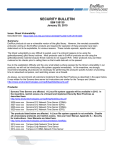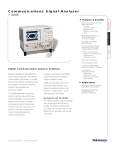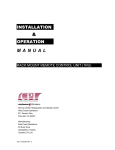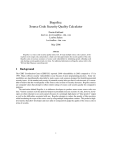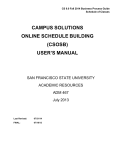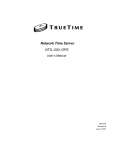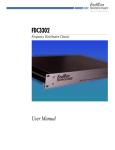Download Meridian II Datasheet
Transcript
Time and Frequency Standards Meridian II Precision TimeBase "Smarter Timing Solutions" GPS-Synchronized, Modular Time and Frequency Standard The Meridian II Precision TimeBase is a high-performance, modular, network-centric, time and frequency standard that generates signals with unparalleled accuracy, stability and spectral purity. The second-generation Meridian II combines our state-of-the-art time and frequency technology with a powerful network timing packet engine to synchronize virtually any stand-alone or network-connected system. The modular architecture allows you to configure Meridian II to meet your requirements of today, and add option modules in the field to meet future needs. Meridian II’s high-reliability design and trouble-free operation, combined with our efficient sales and support, provides the lowest total cost of ownership in the industry. Meridian II supports mission-critical operations in a wide range of government and commercial applications including telecommunications, satellite communications, digital video broadcast, simulcast radio, test range, test and measurement, calibration labs, power utilities and many more. GPS Timing and Frequency Control At the core of Meridian II is an EndRun GPS Receiver optimized to provide an industrybest Coordinated Universal Time (UTC) accuracy (<10 nanoseconds RMS) and stability (<1 part in 10-13 per day). An advanced timing and adaptive 3rd-order frequency-control algorithm maximizes the stability of the Meridian II outputs. User Configurable, Modular Design The system’s modularity supports a suite of field installable, plug-and-play option modules. Up to five modules can be accommodated, providing up to 23 time and frequency outputs in an efficient 1U chassis. Available output signals include IRIG-B time code, 1/5/10 MHz, ultra-low phase noise, telecom T1/E1, Direct Digital Synthesizer (DDS) from 1-10 MPPS, pulse rates, ASCII time messages, and more. Security Hardened - Dual Gigabit Network Interface Meridian II introduces dual, security-hardened, gigabit-Ethernet ports that provide a high-capacity Network Time Protocol (NTP) server and optional IEEE-1588 Precision Time Protocol (PTP) Grandmaster to synchronize clients on two networks. The IPv4/IPv6 management interface is security hardened to meet the highest Information Assurance (IA) requirements. FEATURES . Modular, plug-and-play design with field-installable options. . Timing accuracy: <10 nanoseconds RMS to UTC(USNO). . Frequency accuracy: <1 x 10 . . Ultra-low phase noise 5 & 10 MHz -13 output options. . Short-term stability <6 x 10 -13 at 1 second (optional). . Dual-gigabit Ethernet ports. . NTP Stratum 1 Server with throughput of 7500 packets per second. . IEEE-1588 PTP Grandmaster - 8 ns hardware time stamping (optional). . Security hardened IPv4/IPv6 interface (SSH, HTTPS). . IRIG-B time code and 1 PPS output. . Up to 5 option modules and 24 output signals. . 1, 5, & 10 MHz sine wave output options. . Telecom T1/E1 output option. . Vibrant display with user-friendly keypad. . Dual AC/DC optional power supplies. . Free technical support and software upgrades. . 60-day money-back guarantee. BENEFITS . Time standard traceable to UTC(USNO). . Frequency standard with atomic clock stability. Reference Oscillators A variety of top-quality quartz and rubidium oscillators are available to handle the full range of holdover, phase noise and shortterm stability requirements. We design and manufacture our own OCXO oscillators to achieve performance and quality not found elsewhere. The proprietary design uses a 3rd-overtone, SC-cut crystal built with the highest-quality components and subjected to rigorous testing to guarantee industry-leading performance. The Ultra-Low Phase Noise option enables spectrally-pure 5 and 10 MHz outputs with phase noise less than -115 dBc and -110 dBc, respectively, at a 1 Hz carrier offset. High Reliability and Two-Year Warranty Meridian II uses EndRun’s power-efficient, fanless design and thermal packaging with an estimated MTBF of over 20 years. The system is made in America, backed by a two-year warranty, a 60-day money-back guarantee, and supported by EndRun’s top notch technical support team free of charge! . High bandwidth network time synchronization via NTP and optional IEEE 1588/PTP. . Ultra low phase noise frequnecy reference for communication systems. . Master Clock with time code generator. . High security and reliability. number of satellites in view, carrier-to-noise ratio, and the automatic-gain-control (AGC) are key metrics that reflect the quality and operation of the GPS receiver. The Oscillator chart shows the internal chassis temperature, oscillator electronic frequency control value and the offset of the receiver subsystem to the GPS reference. It is useful for verifying that the unit was locked to the GPS system at a certain time. The NTP statistics chart shows the NTP packets sent, packet rate and the accuracy of the NTP/System Time relative to UTC. The CPU statistics chart shows the free memory, processor load and CPU temperature. Secure Web Interface (HTTPS) for System Monitoring & Firmware Upgrades Web Interface The Meridian II web interface is designed with security in mind, so its use is restricted to monitoring status, alarms, configuration settings, and installing firmware upgrades. Configuration and control is conducted via the network or serial command line interface. Firmware upgrades are enabled only after an authentication process. In addition, the web interface can be completely disabled for those who need the highest level of security. The web page tabbed panels offer quick access to information about the GPS Receiver, Clock, I/O, Faults, NTP, PTP and the Firmware. Firmware upgrades are easy with the point & click upgrade process. Also, a link to the resident User Manual is available on the Home page. Security-Hardened Network Interface Extra care has been taken with Meridian II to “harden” it against network attacks and achieve the highest level of information assurance. It was developed with the latest version of the Linux operating system and security protocols. The Linux distribution is based on Slackware, a distribution that is famed for its security. In a purpose-built appliance like Meridian II, there are only a few settings that need to be made that are typically set only once in the lifetime of the product. Since this is a set-it-and-forget-it box, we have eliminated all extraneous protocols/services in order to minimize exposure to security holes. Configuration is primarily performed via the secure SSH interface although Telnet (if enabled) and the serial port are also available. Monitoring of system status and alarm information is easily accomplished via the secure HTTPS webpage interface, command line interface (SSH, Telnet, serial port), or SNMP. Securityconscious users can further strengthen the network interface by disabling protocols (e.g HTTPS, Telnet) and restrict network access to specific hosts. We designed Meridian II in such a way that it is not necessary for you to know Linux to use the product. For those users who are familiar with Linux, we make it easy for you to customize various aspects of the operation to your requirements. Full User Control Configuration and control is accomplished through either the front-panel keypad/display, network or serial ports. A handful of simple commands and interactive configuration wizards are provided for you to setup and control the product. Online help for all of the Meridian II-specific commands is available, as well as the standard help (manual) files for all of the available Linux commands. Charts available for GPS, Oscillator, NTP and CPU statistics Measurement Statistics and Charting Real-time charting of GPS, Oscillator, NTP and CPU statistics are available via the Web Interface. Measurements are continuously computed and displayed in real-time with daily and weekly charts. The charts are automatically archived into month and year directories that remain resident for up to ten years. The GPS chart provides a valuable, quick reference to assess the current and historical status of the GPS link to insure the Meridian II is and was performing to specification. The Dual Gigabit Ports Two independent 10/100/1000 Base-T Ethernet ports are provided. The ports are capable of generating 7,500 NTP packets per second with a timestamp accuracy of better than 10 microseconds. For PTP/IEEE-1588 applications, you can purchase the option to run on one or both ports with a timestamp accuracy of less than 8 nanoseconds. See the PTP/IEEE-1588 option datasheet for details on using Meridian II as a PTP Grandmaster. Dual Gigabit Ports Meridian II Rear Panel with Five Option Modules Installed Meridian II Inputs, Outputs and Options Meridian II provides a complete suite of time and frequency capabilities with an exceptionally high number and variety of outputs in a standard 1U high chassis. The modular, plug-and-play design of Meridian II and wide range of option cards make it easy to tailor the unit to support your applications. The base Meridian II supports several outputs via the standard CPU module that can also be expanded with options. CPU Module The CPU module is standard on all Meridian II units and includes the GPS receiver antenna input, RS-232 console port, and three timing ports for 1 PPS, AM Code and Spare (for options). The 1 PPS reference is a positive pulse with the leading edge exactly on-time. The AM code output provides user-selectable IRIG-B formats as well as NASA-36 and 2137 time codes. The dual-gigabit Ethernet ports support two networks. The following section describes the options available on the CPU Module: Programmable Pulse Output (PPO) Option The PPO Option provides user-selectable, on-time pulses at decade rates from 1 PPS to 10 MPPS (1, 10, 100, 1k, 10k, 100k, 1M, 10 MPPS). Other selections are 1PPM (pulse per 60 seconds, on the minute), 1PP2S (pulse per 2 seconds, on the even second), and Inverted 1 PPS (falling edge on-time). The PPO output is provided on the Spare BNC. 1 PPS Output Option Additional 1 PPS outputs can be provided on the Spare BNC. A 1 PPS at RS-422 levels is available via a DB9M connector in lieu of the Spare BNC. Direct Digital Synthesizer (DDS) Option The DDS Option provides user-selectable pulse rates from 1 PPS to 10 MPPS, in 1 PPS steps. The DDS output is provided on the Spare BNC. 10 MPPS Output Option The 10 MPPS Rate Output Option provides a fixed on-time pulse rate on the Spare BNC. Alarm Output Option The Alarm option provides an open-collector output to indicate a major alarm condition such as loss of GPS system lock. The Alarm output is commonly connected to a switch and distribution chassis and is installed on the Spare BNC or a terminal block. Serial Time Output Option The Serial Time Output consists of a once-per-second, ASCII time message to sync computer systems or equipment. Format selections are Sysplex, Truetime, EndRun, NENA and NMEA. The output is at RS-232 or RS-422 levels on a DB9M connector. Power Supply Options The Meridian II is equipped with an AC power supply and supports an optional DC supply. For high reliability, dual-redundant power supplies are supported in AC/AC, AC/DC or DC/ DC configurations. A dual power supply configuration occupies two option slots. -- AC power supply: 90-132/180-264 VAC. -- DC power supply: 12, 24, 48, or 125 VDC. -- Connector type: IEC 320 (AC), 3 position terminal block (DC). Modular Plug-and-Play Architecture Meridian II’s versatile, modular design allows you to custom configure the unit to meet your application requirements. The plug-and-play architecture supports up to 5 option modules and 23 time and frequency outputs. Option modules are normally installed at the factory, but most are available as field upgrades. An important benefit of a modular system is that you can add modules in the field as needed to accommodate future requirements. At power-on/boot time, the Meridian II software performs a system scan, detects the installed modules, and configures them per your configuration settings. Following is a summary of the standard Meridian II option modules. For a detailed description, please see the Meridian II Options data sheet. Digital Output Module This module adds four buffered, digital signal outputs to your Meridian II. The module is popular to distribute digital pulse rates and time code. -- Signal types: 1PPS, Programmable Pulse Output (PPO), Time Code, Direct Digital Synthesizer (DDS) at integer rates between 1 PPS and 10 MPPS. -- Signal level and connector: TTL (BNC), RS-232 (DB9M), or RS-422 (DB9M). Analog Time Code Output Module This module adds four buffered analog time code outputs to your Meridian II that match the user selected format of the CPU AM Code output. -- Signal types: IRIG-B120 (IEEE-1344), IRIG-B122, IRIG-B123, NASA-36, or 2137. -- Signal level and connector: 1 Vrms (BNC). Low Phase Noise Output Module This module outputs four spectrally pure frequency signals with high port-to-port isolation. When distributing low phase noise, best practice is to establish direct point-to-point connections to receiving equipment with high quality cable. The low phase noise level and stability is dependent on the Meridian II’s reference oscillator. -- Signal types: 5, 10 MHz. -- Signal level and connector: +13dBm (BNC). Sine Wave Output Module This module adds four frequency outputs to your Meridian II for customers that do not need high-performance low phase noise. The stability is dependent on the Meridian II’s reference oscillator. -- Signal types: 1, 5, or 10 MHz. -- Signal level and connector: +13dBm (BNC). Telecom Clock Module This module adds two telecom outputs to enable Meridian II as a Primary Reference Clock. A full suite of telecom signal types and formats are available to provide high-stability Building Integrated Timing Supply (BITS) clock signals directly to digital equipment. An optional alarm port is also available. An oscillator upgrade to an OCXO or rubidium is required to meet G.811, G.823 and G.824 standards. -- Signal types: T1, J1, E1, Composite Clock, 1.544/2.048 Mbps. Optional Alarm. -- Connector type: RJ48C or DB9M. Meridian II Precision TimeBase Specifications GPS RECEIVER ------- TIMECODE CHARACTERISTICS L1 Band - 1575.42 MHz. 12 Channels, C/A Code. 15 dB minimum gain at receiver input. Static and dynamic (ship board) operating modes. Timing Receiver Autonomous Integrity Monitoring (TRAIM). TNC connector (female) on rear panel, Zin = 50Ω. 5 VDC to antenna. -- Signal: Amplitude-modulated (AM), 3:1 ratio, 1 kHz carrier, 1 Vrms into 50Ω. -- User-Selectable Formats: IRIG-B120 (IEEE-1344), IRIG-B122, IRIG-B123, NASA-36, or 2137. SERIAL I/O PORT -- RS-232 serial I/O on DB9M jack for secure, local terminal access. -- Parameters fixed at 19200 baud, 8 data bits, no parity, 1 stop bit. SYSTEM STATUS INDICATORS ANTENNA ------ -- Sync LED: Amber LED pulses to indicate lock status. -- Alarm LED: Red LED indicates a serious fault condition. 40 dB gain LNA with band-pass filter for out-of-band interference rejection. Rugged, all-weather housing capable of operation over -40˚ to +85˚C. 50’ low-loss RG-59 cable. Optional lengths up to 1000’ with preamplifiers. Mounting kit: 18” long, 3⁄4” PVC pipe with clamps. TNC connector (female), Zout = 50Ω. 5 VDC input. ALPHANUMERIC DISPLAY/KEYPAD -- Display: Brilliant 16x280 dot-matrix vacuum-fluorescent. -- Keypad: Enter, Back, Edit, Right, Left, Up, Down, Help. 1 PPS TIMING CHARACATERISTICS POWER The following accuracy and stability specifications assume a stationary platform, 4 satellite lock, and antenna installation with a full view-of-the-sky. -- Accuracy: <10 nanoseconds RMS to UTC(USNO) when locked*. -- Stability: TDEV <10 ns @ τ <105 secs, σy(τ) <1x10-13 @ τ=105 secs. -- Positive TTL pulse into 50Ω (standard) or RS-422 levels (option). -- User-Selectable Width: 20 us, 1 ms, 100 ms, 500 ms. -- User Calibration: +/- 500 us, 1 ns resolution. * See GPS-UTC Timing Specifications for details. -- 90-264 VAC, 47-63 Hz, 1.0A Max. @ 120 VAC, 0.5A Max. @ 240 VAC. -- 3-Pin IEC 320 on rear panel, 2 meter cord included. SIZE -- Chassis: 1.75”H x 17”W x 10.75”D. -- Weight: <5 pounds. -- Antenna: 2.5”H x 3.5”diameter. ENVIRONMENTAL LOCAL REFERENCE OSCILLATOR -- Temperature: 0°to +50˚ C. -- Humidity: 0 to 95%, non-condensing. Several oscillator options are available to meet your short-term stability at 1 second (STS), phase noise at 1 Hz offsets in dBc/Hz (LPN) , ageing rate/year (AGE RATE), and temperature stability for 0-70˚ C (TEMP STAB): OSCILLATOR STS (1 sec) LPN 10/5 MHz AGE RATE TEMP STAB -- TCXO (standard) 1x10-9 -70/na 1x10-6 2.5x10-6 -- Medium Stability-OCXO 3x10-12 -95/-100 3x10-8 4x10-9 -- High Stability-OCXO 1x10-12 -105/-110 3x10-8 1x10-9 -- Ultra Stable-OCXO 6x10-13 -110/-115 3x10-8 5x10-10 -- Rubidium 2x10-11 -80/na 1x10-9 1x10-9 -- High Stability Rubidium 2x10-11 -80/na 5x10-10 1x10-10 See Oscillator Options datasheet for more information. COMPLIANCE -- CE, FCC, RoHS, WEEE. GPS ANTENNA and ACCESSORIES A GPS Antenna Kit is included with the Meridian II consisting of an antenna, 50 ft cable, mounting pipe, and clamps. Extended cable lengths, lightning arrestors, in-line amplifiers, splitters, and fiber optic links are also available. TIME TO LOCK -- < 5 minutes, typical (TCXO). < 10 minutes, typical (OCXO/Rb). NETWORK I/O -- Two rear-panel RJ-45 jacks. -- 10/100/1000Base-T Ethernet. NETWORK PROTOCOLS ----------- IPv4/IPv6. SNTP, NTP v2, v3, v4, MD5/autokey authentication, broadcast/multicast mode. SSH client/server with “secure copy” utility, SCP. SNMP v1, v2c, v3 with Enterprise MIB. HTTPS (Web Interface). TIME and DAYTIME server. TELNET client/server. FTP and DHCP clients. SYSLOG. PTP/IEEE-1588-2008 (v2) Grandmaster. 8 ns hardware time stamping (Optional). MERIDIAN II OPTIONS Refer to the Meridian II Options datasheet for detailed information on all options. RELATED PRECISION TIMEBASE The Tycho II is similar to the Meridian II but with reduced accuracy specification of 25 ns to UTC(USNO) and without the front-panel keypad/display. RELATED DISTRIBUTION PRODUCTS EndRun provides frequency, pulse and time code distribution products to expand Meridian outputs: FDC3302 High-Performance Frequency Distribution Chassis FDC3300 Frequency Distribution Chassis PDC3301 Pulse Distribution Chassis TDC3303 Time Code Distribution Chassis NETWORK SYNCHRONIZATION ACCURACY -- NTP Timestamp Accuracy: < 10 microseconds to UTC(USNO) @ 7,500 packets/second. -- PTP Timestamp Accuracy to Reference Clock: 8 nanoseconds. "Smarter Timing Solutions" Santa Rosa, CA CA, USA 1-877-749-3878 or 707-573-8633 [email protected] www.endruntechnologies.com 150914 Data subject to change.




